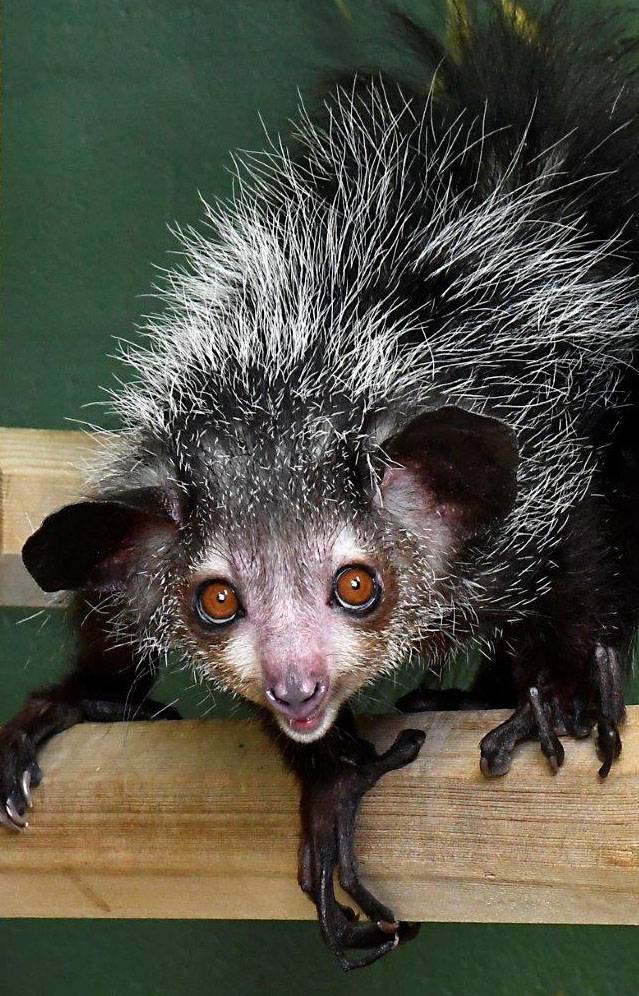The aye-aye (Daubentonia madagascariensis) is one of the most unusual and least understood mammals in the world. Found exclusively in Madagascar, this rare primate belongs to the lemur family, yet its physical appearance and behavior make it seem like a creature from mythology. With its haunting eyes, bat-like ears, elongated fingers, and nocturnal habits, the aye-aye has fascinated researchers and puzzled locals for centuries. This comprehensive exploration delves into the biology, behavior, habitat, cultural significance, and conservation status of this extraordinary animal.
Physical Characteristics: A Primate Unlike Any Other
The aye-aye is often described as a mix of several different animals. At first glance, it resembles a mix of a squirrel, bat, and primate, but upon closer inspection, its distinct adaptations set it apart from any other known species.
Size and Appearance
Aye-ayes are medium-sized primates, measuring about 14 to 17 inches (36 to 43 cm) in body length, with an additional 22 to 24 inches (56 to 61 cm) of bushy tail, which is longer than their body. They typically weigh between 4 to 6 pounds (1.8 to 2.7 kg). Their fur is coarse, shaggy, and dark brown or black, with occasional white streaks.
Their large, round eyes are adapted for nocturnal vision, allowing them to see in low-light conditions. Their ears are large and bat-like, capable of picking up the faintest sounds, which aids them in their unique foraging method known as percussive foraging.
One of the aye-aye’s most peculiar features is its elongated middle finger, which is long, thin, and almost skeletal in appearance. This finger is highly flexible and is used to tap on tree bark to locate hollow chambers where insects hide. It is also essential for extracting larvae from deep within wood crevices, making the aye-aye one of the few primates that rely on echolocation for feeding.
Unique Feeding Adaptations: The Woodpecker Primate
The aye-aye is sometimes referred to as “Madagascar’s woodpecker” because of its unusual feeding behavior. Unlike any other primate, it employs a technique called percussive foraging to find its food.
Diet
Aye-ayes are omnivorous, meaning they consume both plant and animal matter. Their diet primarily consists of:
- Insect larvae
- Nuts and seeds
- Fruits such as coconuts and mangoes
- Nectar and fungi
They have continuously growing incisors, similar to rodents, which they use to gnaw into hard tree bark and nuts. However, their most impressive adaptation is their elongated middle finger, which they use in a three-step process:
- Tapping – The aye-aye rapidly taps on tree bark using its long middle finger, listening for hollow sounds that indicate the presence of larvae inside.
- Gnawing – Once it detects a cavity, it uses its sharp teeth to create a hole.
- Extracting – The middle finger then extends into the hole, hooking and pulling out the prey.
This method of food extraction is unique among primates and closely resembles the feeding behavior of woodpeckers.
Nocturnal and Solitary Lifestyle
Aye-ayes are strictly nocturnal, meaning they are active only at night. During the day, they rest in spherical nests made of leaves and twigs, typically found high in the treetops. These nests provide camouflage and protection from predators.
They are solitary animals, with males having large overlapping territories and females maintaining smaller, exclusive ranges. They communicate using vocalizations such as clicks, grunts, and high-pitched calls, as well as scent marking.
Reproduction and Lifespan
The reproductive habits of aye-ayes are not well-documented due to their elusive nature. However, researchers have observed some key aspects of their breeding behavior.
- Aye-ayes do not have a specific breeding season and can mate at any time of the year.
- The female signals her readiness by emitting vocalizations and scent markings.
- Males compete aggressively for access to a receptive female.
- After mating, the female carries the pregnancy for about 160 to 170 days before giving birth to a single infant.
- The infant is dependent on its mother for over a year, a long period compared to other primates of similar size.
Aye-ayes have a relatively long lifespan, living up to 20 years in captivity and slightly less in the wild due to predation and habitat threats.
Habitat and Distribution
Aye-ayes are found only in Madagascar, an island nation off the coast of Africa. They inhabit rainforests, dry forests, and coastal areas, but they are most commonly seen in primary and secondary forests.
Due to deforestation and habitat destruction, their range has become increasingly fragmented, forcing them to adapt to degraded environments and even agricultural lands.
Cultural Significance and Superstitions
The aye-aye has long been associated with superstition and folklore in Malagasy culture. Many locals believe it is a harbinger of bad luck or even a symbol of death. One of the most widespread legends states that if an aye-aye points its long, bony finger at someone, that person will soon die.
Because of these beliefs, aye-ayes have been hunted and killed on sight in many rural communities, contributing to their declining numbers. Despite efforts to educate locals about their ecological importance, traditional fears persist.
Threats and Conservation Status
The aye-aye is currently classified as Endangered by the International Union for Conservation of Nature (IUCN). Its primary threats include:
1. Habitat Destruction
- Deforestation due to agriculture, logging, and human settlements has significantly reduced aye-aye populations.
- Slash-and-burn farming practices destroy the forests where aye-ayes nest and forage.
2. Hunting and Persecution
- Superstitious beliefs lead to the intentional killing of aye-ayes.
- In some areas, they are hunted as food, though this is less common.
3. Climate Change
- Rising temperatures and erratic weather patterns threaten Madagascar’s ecosystems.
- Droughts and habitat degradation impact food availability for aye-ayes.
Conservation Efforts
Several conservation organizations and research institutions are working to protect aye-ayes and their habitats:
- Madagascar National Parks: Protecting forest reserves where aye-ayes live.
- Durrell Wildlife Conservation Trust: Conducting research and breeding programs to help increase aye-aye numbers.
- Captive Breeding Programs: Zoos and research centers worldwide, such as the Duke Lemur Center in the U.S., have successfully bred aye-ayes in captivity.
Education and awareness programs are also crucial in changing local attitudes toward aye-ayes, helping people see them as essential members of Madagascar’s ecosystem rather than omens of misfortune.
Why the Aye-Aye Matters
Despite its eerie appearance and the myths surrounding it, the aye-aye plays a critical ecological role in Madagascar’s forests. As an insectivore and seed disperser, it helps control insect populations and promotes forest regeneration.
Understanding and protecting the aye-aye is not just about saving a single species—it’s about preserving the unique biodiversity of Madagascar, one of the most ecologically rich places on Earth.
Conclusion
The aye-aye is one of nature’s most bizarre and intriguing mammals. With its nocturnal habits, percussive foraging technique, and long, skeletal fingers, it stands out as a marvel of evolution. While it faces threats from deforestation, hunting, and superstition, conservation efforts are making a difference.
By spreading awareness and protecting its natural habitat, we can ensure that this rare and mysterious primate continues to thrive in the wild. The aye-aye is a testament to the wonder of evolution and a reminder of the importance of preserving Earth’s most unique creatures.



